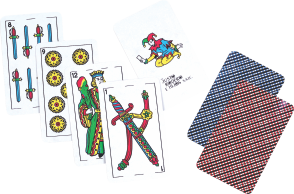
General rules
This game, also very popular, is played with the pack of 40 cards. As many players as they want can partcipate, although normally it´s played between two or four. If the game takes place between four, the players go as Partners, by couples. The formation of them is done by chance of simply by Challenger. This game is quite similar to “tute”.
When it is played by partners, that is, one couple against the other, the players will sit alternatively, so that the team is face to face. It is determined by chance who will deal the cards, the player cosen will shuffle the cards and will have it cut by the player sitted at his left, who will cut without taking less than four cards and withour leaving less than four.
The one who deals, distributes then the cards giving three to each player (starting by the one to the right), and giving three to himself. Once finished this, he puts face up the inferior card of the pack, that will mark the suit of the triumph, leaving it in that position on the table with the pack on top of it. As the card that indicates the triumph can be valuable, it can be taken by the player that has the seven of the same suit, leaving it in the place of the other; the seven, also, can be replaced by the two.
The change of card that marks the triumph for the seven or the two, can only be made before having played the penultimate trick.
The player” hand” then throws a card over the table, the one who is next must “servir el palo”, that is, play the same suit that has played the first. If he doesn´t have a card of the same suit, he has the obligation to play a triumph, if he hasn´t none of the two he can play any other card. It is not an obligation to beat the card played in the first place.
The rest of the players proceed in the same way. When all have played their cards, the trick is lifted by the one who won it (playing in partnership it can be lifted by any member of the couple). The one who won the trick “steals” then a card from the pack, operation that all the players repeat, following their turn.
The winner of the previous trick comes then from a card, following the game as explained, the “hand” or turn ends when the cards of the pack and the ones the players have in their hands, finish.
The idea is to reserve the more valuable cards, trying for the oposition to waste without benefit the triumphs they have. The triumph cards, as little value as they have, beat any of those of another suits.
Therefore, if the triumph is gold, the two of this suit will beat the ace of any of the other three suits. Each game won represents a point. The quantity of them is fixed beforehand and each game can consist in one or more sets.
To win, it´s necessary to gather more than 60 points. The distribution of the cards is done by each player, by turn, when finishing each round, following the order from right to left. It´s forbiden to tell the partner what cards one has, except with a code of signals whose efficiency is doubtful, as the opponents can know them too and surprise their rivals in the moment they do them.
The signs more often used are the following:
Ace of Triumph: Look upwards.
Three of Triumph: Wink an eye.
King of Triumph: Extend the lips frontwise.
Queen of Triumph: Twist the mouth to the right.
Jack of Triumph: show the tip of the tongue.
Aces: The aces that are not triumphs are called “briscas”, and their possesion is signaled tilting the head.
When they haven´t got triumphs: Closing the eyes.
For the companion to play a valuable card (not a triumph): Blowing.
For the companion to indicate what he has got: Look at him fixedly.
Value of the cards
It´s similar in all the suits and is the following:
Ace, 11 points
Three, 10 points
King, 4 points
Queen, 3 points
Jack, 2 points
The rest of the cards have no value for the adding of the points, but yes to beat a lower one, for example, the seven to the six, etc.
La Brisca al Revés
Nearly all the games can be played backwards, to give more variety and fun to the meetings. We understand playing backwards to do everything possible to win, loosing, that is, to try to do the fewer possible points and try, also, for the opponents to do as many points as possible. The game is won by who makes the less points, and therefore, it´s necessary, in the “brisca” backwards, to give the oposition all the valuable cards possible, keeping the ones of less value, that give few points. This form of playing causes enjoyable situations that contribuye to extract the maximum profit from the cards.
La Brisca a Ciegas
In this style, the player must not see the cards he has received.He plays them, therefore, without seen them until they are already played. That means that the players can´t do nothing to try to win, and only the whim of luck decides de end of the game.
